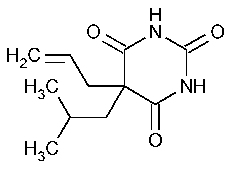Butalbital
2,4,6(1H,3H,5H)-Pyrimidinetrione,5-(2-methylpropyl)-5-(2propenyl)-.
5-Allyl-5-isobutylbarbituric acid [77-26-9].
»Butalbital contains not less than 98.0percent and not more than 102.0percent of C11H16N2O3,calculated on the dried basis.
Packaging and storage—
Preserve in well-closed containers.
Identification—
A:
Infrared Absorption á197Kñ.
B:
Ultraviolet Absorption á197Uñ—
Solution:
15µg per mL.
Medium:
0.1Nsodium hydroxide.
Absorptivities at 246nm,calculated on the dried basis,do not differ by more than 2.5%.
Loss on drying á731ñ—
Dry it in vacuum at room temperature to constant weight:it loses not more than 0.2%of its weight.
Residue on ignition á281ñ:
not more than 0.1%.
Heavy metals,Method IIá231ñ:
0.002%.
Chromatographic purity—
Chloroform-methanol—
Mix equal volumes of chloroform and methanol.
Standard preparations—
Dissolve a quantity of USP Butalbital RSin Chloroform-methanolto obtain a solution having a concentration of 40mg per mL(Solution A).Dilute 1.0mLof Solution Awith Chloroform-methanolto 100mL,and mix (Solution B);mix 5.0mLof Solution Bwith 5.0mLof Chloroform-methanol(Solution C);and mix 5.0mLof Solution Cwith 5.0mLof Chloroform-methanol(Solution D).
Test preparation—
Dissolve a quantity of Butalbital in Chloroform-methanolto obtain a solution having a concentration of 40mg per mL.
Procedure—
In a suitable chromatographic chamber,arranged for thin-layer chromatography and lined with filter paper,place a volume of a developing solvent consisting of a mixture of acetone,dichloromethane,methanol,and ammonium hydroxide (50:30:10:10)sufficient to develop the chromatogram.Cover the chamber,and allow it to equilibrate for 30minutes.Apply 10µLeach of the Test preparationand Solutions A,B,C,and Dto a suitable thin-layer chromatographic plate (see Chromatography á621ñ)coated with a 0.25-mm layer of chromatographic silica gel mixture.Develop the chromatogram until the solvent front has moved about three-fourths of the length of the plate.Remove the plate from the developing chamber,mark the solvent front,and dry the plate in a current of air.Spray the plate with a reagent prepared by dissolving 5g of potassium hydroxide in a mixture of 25mLof water and 75mLof alcohol.Allow the plate to dry in warm air for 10minutes,and examine the chromatograms under UVlight:the chromatograms show principal spots at about the same RFvalue;and the sum of the intensities of any secondary spots,if present in the chromatogram from the Test preparation,is not greater than 1%of that of the principal spot from Solution A.[NOTE—The relative intensities of the principal spots from the Standard preparations are:Solution A,1;Solution B,0.01;Solution C,0.005;and Solution D,0.0025.]
Organic volatile impurities,Method Vá467ñ:
meets the requirements.
Solvent—
Use dimethyl sulfoxide.
Assay—
Dissolve about 180mg of Butalbital,accurately weighed,in a mixture of 25mLof alcohol and 25mLof sodium carbonate solution (3in 100),and titrate with 0.1Nsilver nitrate VS,determining the endpoint electrometrically,using a silver electrode,either with a suitable reference electrode containing a saturated aqueous solution of potassium nitrate,or a combination electrode in which the reference portion of the electrode contains a saturated aqueous solution of potassium nitrate.Each mLof 0.1Nsilver nitrate is equivalent to 22.43mg of C11H16N2O3.
Auxiliary Information—
Staff Liaison:Ravi Ravichandran,Ph.D.,Senior Scientist
Expert Committee:(PA3)Pharmaceutical Analysis 3
USP28–NF23Page 303
Phone Number:1-301-816-8330
